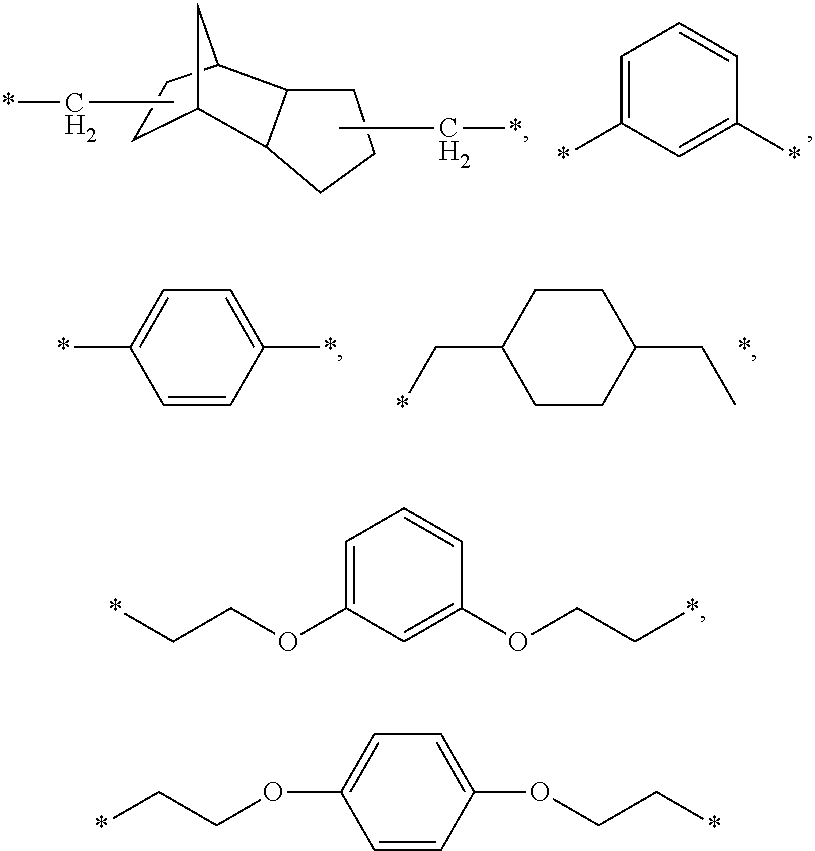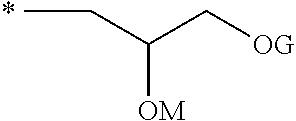Dental composition, method of producing and use thereof
a technology of dental composition and composition method, applied in the field of dental composition, can solve the problems of material fracture and material replacemen
- Summary
- Abstract
- Description
- Claims
- Application Information
AI Technical Summary
Benefits of technology
Problems solved by technology
Method used
Image
Examples
##ventive example 1
Inventive Example 1
[0269]According to General Procedure 1 116 g of ER, 172 g of GP were reacted using THF as solvent and KOtBu as catalyst. 239 g of ERGP (479 mmol, 82%) were isolated as yellowish liquid. According to General Procedure 4 157 g of ERGP, 81.4 g of MA, 30.0 mg of BHT, 80.0 mg of HOME, and 11.5 g of MSA were reacted using toluene as solvent. 76.4 g of ERGP-MA (120 mmol, 38%) were isolated as yellowish oil: η=9.4 Pa*s, nD20=1.542.
Synthesis of ERGP-A
##ventive example 2
Inventive Example 2
[0270]According to General Procedure 1 116 g of ER, 172 g of GP were reacted using THF as solvent and KOtBu as catalyst. 239 g of ERGP (479 mmol, 82%) were isolated as yellowish liquid. According to General Procedure 4 165 g of ERGP, 71.5 g of Acrylic Acid (AA), 28.0 mg of BHT, 77.0 mg of HOME, and 6.50 g of MSA were reacted using toluene as solvent. 172 g of ERGP-A (284 mmol, 86%) were isolated as yellowish oil: η=18.8 Pa*s, nD20=1.547.
Synthesis of ERGP-Ac
##ventive example 3
Inventive Example 3
[0271]According to General Procedure 1 116 g of ER, 172 g of GP were reacted using THF as solvent and KOtBu as catalyst. 239 g of ERGP (479 mmol, 82%) were isolated as yellowish liquid. According to General Procedure 4 60.0 g of ERGP, 24.9 g of Acetic Acid Anhydride (AAA) were first reacted using toluene as solvent, then 630 mg of para-Toluene Sulfonic Acid (pTSA) were added and water was removed. 48.6 g of ERGP-Ac (84.0 mmol, 69%) were isolated as yellowish oil: η=22.6 Pa*s, nD20=1.540.
Synthesis of TGP-MA
PUM
| Property | Measurement | Unit |
|---|---|---|
| Flexural strength | aaaaa | aaaaa |
| Depth of Cure | aaaaa | aaaaa |
| Flexural strength | aaaaa | aaaaa |
Abstract
Description
Claims
Application Information
 Login to View More
Login to View More - R&D
- Intellectual Property
- Life Sciences
- Materials
- Tech Scout
- Unparalleled Data Quality
- Higher Quality Content
- 60% Fewer Hallucinations
Browse by: Latest US Patents, China's latest patents, Technical Efficacy Thesaurus, Application Domain, Technology Topic, Popular Technical Reports.
© 2025 PatSnap. All rights reserved.Legal|Privacy policy|Modern Slavery Act Transparency Statement|Sitemap|About US| Contact US: help@patsnap.com



